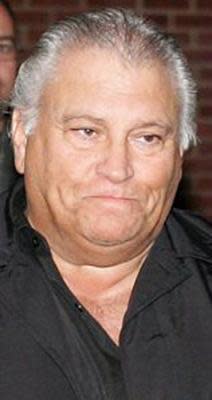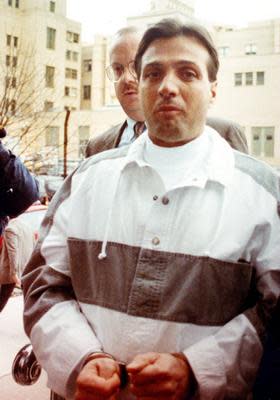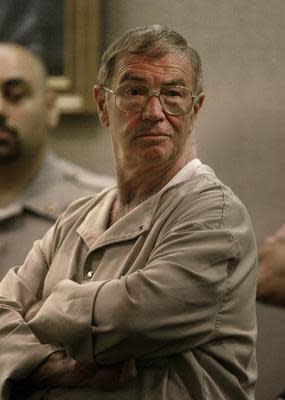Organized crime has a long history at the Jersey Shore
ASBURY PARK, N.J. – The arrest Saturday in New Jersey of a 24-year-old man who was charged with murder in the slaying of reputed Gambino family boss Francesco "Franky Boy" Cali, is just the latest link between the Jersey Shore and organized crime.
Mobsters have had a long love affair with the Shore, dating back to Prohibition days.
Middletown's Deep Cut Park was once the estate of mob boss Vito Genovese, who bought it in 1935; it burned down in 1937. Genovese later relocated to Atlantic Highlands, where he lived from 1949 to 1959, when he went to prison.
In more recent times, Angelo Prisco, a reputed Genovese crime family captain, divided his time between the Bronx and Toms River, where he had a town house. Prisco was was convicted on murder and racketeering charges in 2002.

On Saturday, officials with the New York Police Department identified Anthony Comello as the suspect in the Cali slaying. Comello is being held in the Ocean County Jail in Toms River, after his arrest in Brick, New Jersey, pending extradition to Staten Island, where he will face murder charges, according to the NYPD.
Cali, 53, was found dead outside his Staten Island home Wednesday night, after being shot 10 times in the torso, the NYPD said.
Police had no updates on Comello on Sunday.
Population growth lures organized crime
Members of organized crime families and their associates weren't just drawn to the Shore for the sea and salt air.
The rapid growth of Monmouth and Ocean counties in the 1960s and 1970s created business opportunities for mob families, according to a 1972 Asbury Park Press story. The state Investigation Commission held hearings in February of that year about organized crime in Ocean County.
March 16: NYPD: Man arrested in death of Frank Cali, reputed Gambino crime family boss

Martin Halloran, head of a federal strike force in Essex County, told the commission that mobsters were drawn to Ocean County because of a crackdown on criminal activity by authorities in northern New Jersey, and the population boom in Ocean County.
While towns like Toms River and Brick were growing rapidly, police forces in Ocean County’s expanding towns still remained small, and were initially unable to cope with organized crime, Halloran said. Many members of organized crime families started migrating to the Shore in the early 1960s.
But organized crime existed at the Jersey Shore long before the 1960s and 1970s.
Prohibition days
During Prohibition in the 1930s, rumrunners were a common nuisance for those local law enforcement authorities who were not themselves aiding and abetting the movement of illegal alcohol offshore.
The S.S. Club Royale, a floating speakeasy and casino on the Manasquan River that operated at night out of Point Pleasant Beach was run by organized crime with the apparent tacit approval of Ocean County's political establishment at the time.
After an exposé on the Club Royale ran in the Toms River-based New Jersey Courier on June 6, 1934, publisher William H. Fischer was offered $1,000 in advertising in the Courier by men who presented themselves as agents of the showboat's operators.
March 15: Gambino murder sparks Mafia rumor mill: ‘A couple of guys got to get killed now’
State authorities raided the Club Royale the next month, sweeping aside four private guards standing watch at the gangplank. As the officers boarded the showboat, the crew of the vessel begged the lawmen to wait until the Ocean County sheriff arrived so he could straighten everything out, implying that their criminal enterprise had the protection of county authorities.
Pine Barrens 'dumping ground'
Fast forward to the 1960s, when Ocean County's Pine Barrens became the burial ground of choice for mobsters looking to get rid of the remains of their victims.
“Victims Dumped In Ocean Woods,” was a front page headline in the Asbury Park Press on March 25, 1967.

“Since 1962, one body a year has been found deep in the woods in sparsely settled areas,” the article reported of Ocean County.
On the same day the Press published that article, FBI Director J. Edgar Hoover called a news conference in Washington to announce the results of a two-year investigation into the activities of organized crime in New York and New Jersey, which led his agents to what he described as a “Cosa Nostra cemetery.”
In the backyard of a farmhouse there, one man was found buried in a pit that was used during the Prohibition era to dump the mash of an illegal distillery. Across the road, buried beneath an abandoned chicken coop, was another man – agents found his remains stuffed inside a 55-gallon drum.
Three months later, Brick Mayor-elect John McGuckin was planning his new administration when he said he received a threatening telephone call from someone who claimed to be part of “the family.”
March 14: Alleged Gambino crime boss Frank Cali's slaying a throwback to bygone era, experts say
If the mayor was thinking about making any new appointments to the Planning Board – well, there would be “trouble” went the warning.
McGuckin would tell the Asbury Park Press two days later that the caller explained to him that “the family” – he interpreted the caller to mean the Cosa Nostra (the mafia) – had made it clear they had “plenty of money invested in Brick Township” and the present membership of the Planning Board was favorable to their interests.
During this time, McGuckin – who is the father of current state Assemblyman Gregory P. McGuckin – even went so far as to send his wife and four children away to Pennsylvania for their own safety until he was convinced the threat had passed.
By the 1970s, organized crime figures were well-established at the Shore.
In 1983, a three-year-long state police investigation into organized crime in Ocean County resulted in 18 arrests in connection with criminal activity, including promoting prostitution, maintaining a nuisance, and distributing and conspiring to distribute drugs.
Notorious Ocean County murder
Then, on June 12, 1984, Vincent "Jimmy Sinatra" Craparotta Sr., 56, was bludgeoned to death by three men with golf clubs in perhaps the most notorious mob-related slaying in Ocean County's history.
He was found behind a car dealership. Authorities said Craparotta had an office in the building.

In 1983, Craparotta had been identified as a “significant associate” of the Lucchese crime family by state police, who said he was involved in bookmaking and loansharking in Ocean County.
In August 1993, after a 10-week-long trial Thomas Ricciardi was found guilty of murder, racketeering, extortion and conspiracy in the case; Michael and Martin Tacetta and Anthony “Tumac” Acceturo Sr. were found guilty of racketeering, extortion and conspiracy.
Authorities contend that Craporatta was killed because he resisted efforts by the Lucchese family to take over SMS Inc., a company that made video poker machines. The company was owned by Craporatta’s nephews, Vincent and Pasquale “Pat” Storino, as well as Salvatore Mirando. Mirando was a reputed associate of the Bruno/Scarfo crime family.
Nine years after Craparotta was killed, mob soldier James Randazzo was gunned down in the parking lot of a hotel in 1993. Toms River resident Aurelio "Ray" Cagno was sentenced to life in prison for Randazzo's murder in 2004.
Follow Jean Mikle on Twitter: @jeanmikle
This article originally appeared on Asbury Park Press: Organized crime has a long history at the Jersey Shore
